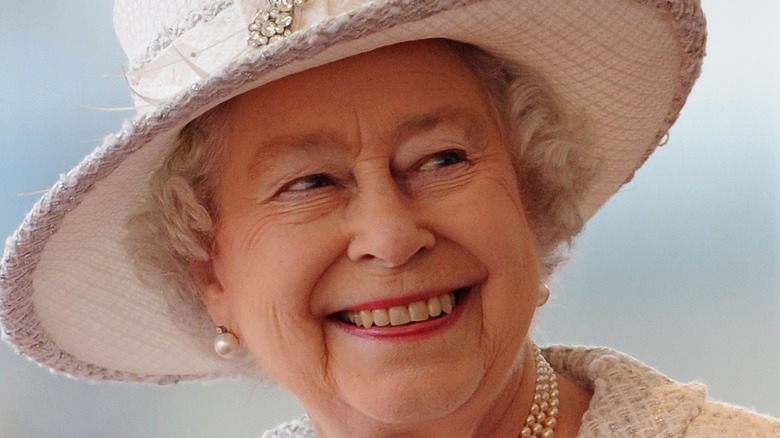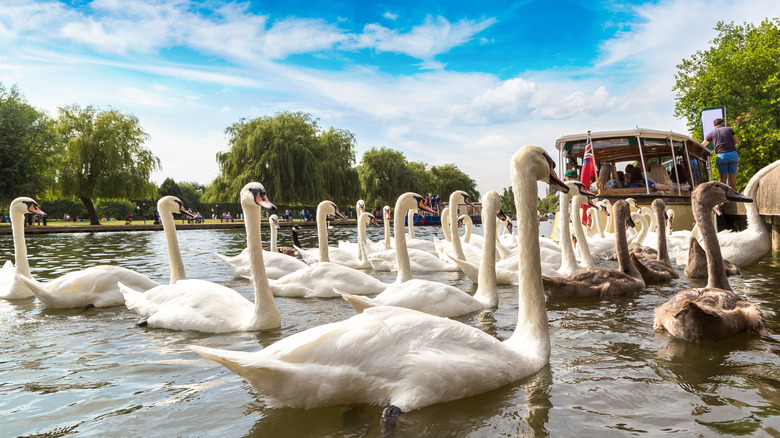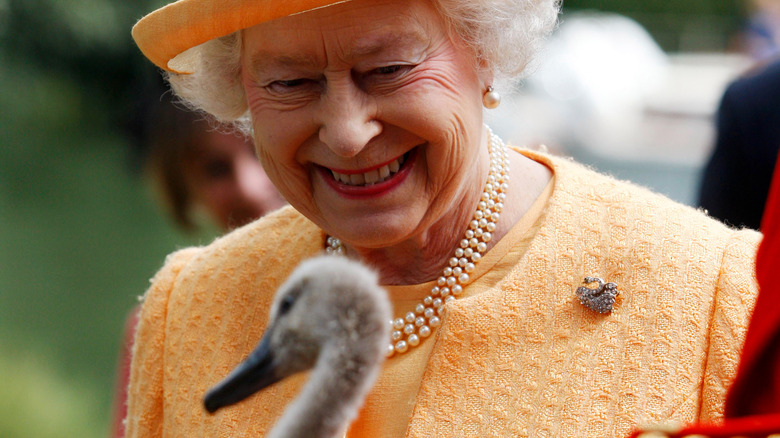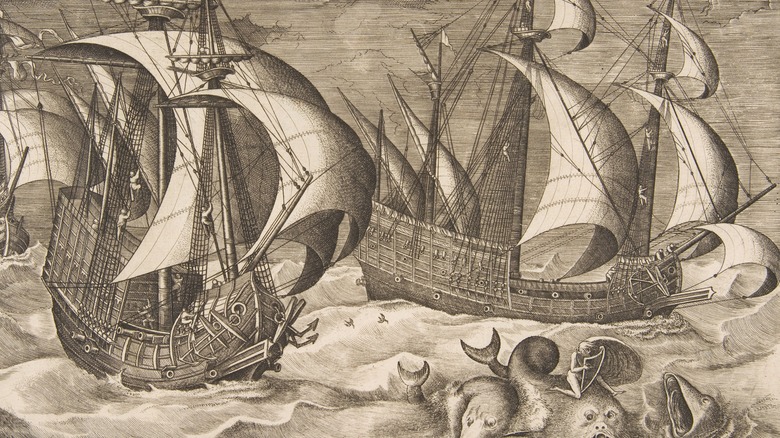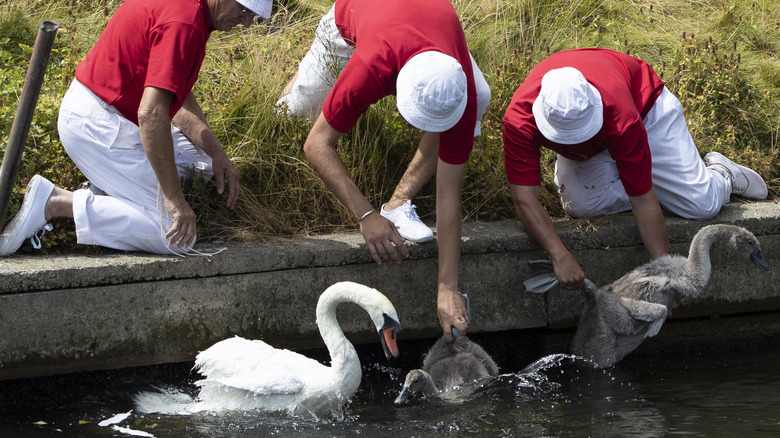The Real Reason Queen Elizabeth Owns All Of The Dolphins And Swans In England
In 2004, a 27-year-old fisherman from South Wales reeled in his net to examine his daily yield from the Swansea Bay. Robert Davies didn't just find his usual haul of carp, pike, and bluefish squirming, but a much, much larger being whose weighty body strained the harnesses of his net's meager nylon and mesh: a 10-foot-long, 264-pound sturgeon. According to a Swansea Coastguard spokeswoman, Davies received a fax from Buckingham Palace telling him to "dispose of it" as he saw fit (via BBC News)
Davies officially had permission from Queen Elizabeth II to offload his prize catch. However, after selling the sturgeon at Plymouth Fisheries the next day, the Devon and Cornwall Police; the Department for Environment, Food, and Rural Affairs; and the Swansea Coast Guard all got involved in what became a massive jurisdictive entanglement over Davies, the sturgeon, and Davies' potential offense to the crown.
Why? Davies had caught a sturgeon, a "royal fish," and all royal fish are owned by the queen.
The 16th-Century Saga of the Swans
Rewind to the year 1512. Dorset locals Dame Joan Young and Thomas Saunger had together rounded up 400 swans, but the sheriff wanted to seize them and give them to the queen, who reportedly desired them. Young and Saunger argued that the queen did not have right to them — the swans were now their property by acquisition. The two Dorset locals took their case to a judge with the aid of Edward Coke and lost. The incident became known as the Case of Swans, and it was the first landmark case in British proprietary law. (Dr. Katy Barnett of Melbourne Law School provides a coherent, context-rich narrative overview of its significance in a guest post on Legal History Miscellany.)
Why? Swans are royal fowl, and all royal fowl belong to the queen. Here's what the court ruled in "The Case of Swans" (via Commonwealth Legal Information Institute): "[A]ll white swans not marked, which having gained their natural liberty, and are swimming in an open and common river, might be seised to the King's use by his prerogative ... as a swan is a royal fowl; and all those, the property whereof is not known, do belong to the King by his prerogative: and so whales and sturgeons are Royal fishes, and belong to the King by his prerogative."
In fact, they still do.
Royal Fish and Royal Fowl
While the first mention of "royal birds" came centuries earlier, the first legal decree of the Crown's right to an entire species of creatures was a 14th-century law instituted by King Edward II. The law declared all dolphins, porpoises, sturgeons, and England's native mute swans the property of the Crown (and therefore, property of the queen). Whether it's 1512, 2004, or 2021, King Edward's decree lives on long past its relevance, as noted in 1322's "Prerogativa Regis" Section XIIJ, and Book I, Chapter 8 of William Blackstone 1765 "Commentaries on the Laws of England."
Under its technical (and quite archaically-delineated) scope, the queen's jurisdiction over "royal fish" includes all dolphins, porpoises, and sturgeon within 3 miles of the British coast or those that were caught and brought onto England's shores. For "royal fowl," this law pertained to all swans native to the United Kingdom (this species is known as the "mute swan," and the law only pertains to those unmarked).
While all unmarked swans were decreed property of the Crown by default, "swan marks" could be purchased from the Crown by wealthy landowners who hoped to own royal fowl of their own. To this day, two wealthy enterprises, the Dyer Company and the Vintner Company, are permitted to own marked swans (via Smithsonian Magazine). It is presumed that the queen owns all the rest (via Atlas Obscura).
Medieval Property Law and Modern Principles
For its era, this law wasn't unprecedented or outrageous by any means. These were the days when common belief held that the monarchy was appointed by God and that monarchs had a lesser, albeit still powerful, essence of divinity to their personages themselves (via JSTOR Daily).
Swans were a luxury fowl, and seafarers considered dolphins spiritually significant beings (as noted by Steve Metz in "'Half-Fish, Half-Flesh': Dolphins, the Ocean, and Early Modern Humans"). For both practical, economic, customary, and asset-related purposes, these "royal" animals were seen as sharing qualities with the monarchy — meaning these animals were valuable symbols or indicators of wealth and power (as noted in Reader's Digest). By applying de facto crown ownership to all these creatures, the Crown could ensure its role as a chief broker of luxury goods and high-value assets, a not-unknown concept at the time, given that fish and fowl are natural creatures and not the products of an economic process.
By declaring that these natural assets — and fowl were assets in medieval England, albeit a luxury one — were de facto the property of the queen, she could be assured the guarantee of whatever pleasures she wished. Remember that in Medieval times, the Crown technically had final dominion and ownership over all of England, so governance of her lesser, albeit more decorous creatures was not as audacious when first decreed as it would be if issued by Parliament today.
The 21st-Century Swan Census
In modern times, Queen Elizabeth II only exercises this power in an annual ceremony that takes place on a stretch of the River Thames. This event is called the "Swan Upping." Otherwise, this 1312 law is not really enforced, according to the Royal Family website.
Each year, the queen's absolute dominion over swankind is commemorated with the 800-year-old tradition of the Swan Upping ceremony, in which the British royal family takes a census of all royal-fowl-related-assets in a decorous days-long celebration on the River Thames. While this ceremony once served a practical purpose rather than a symbolic one, the Swan Upping is now both: the queen presides over her fowl ceremoniously, while conservationists gather useful real-life data on native swan species' health and migratory patterns (via Smithsonian Magazine).
Ultimately, while the queen's ownership of royal fish and fowl is technically enshrined in law, most citations pertaining to swans and dolphins are rooted in concerns of humane animal treatment and other protected species legislation (via The Swan Sanctuary), while laws pertaining to the queen's "ownership" are regarded more as customs. Nonetheless, if you ever catch a 260-pound sturgeon off British coastal waters, don't forget to check with Buckingham Palace. Which, for some reason, also still exists.
